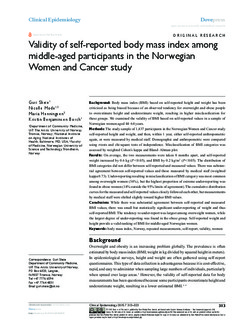| dc.description.abstract | Background: Body mass index (BMI) based on self-reported height and weight has been criticized as being biased because of an observed tendency for overweight and obese people to overestimate height and underestimate weight, resulting in higher misclassification for these groups. We examined the validity of BMI based on self-reported values in a sample of Norwegian women aged 44–64 years.
Methods: The study sample of 1,837 participants in the Norwegian Women and Cancer study self-reported height and weight, and then, within 1 year, either self-reported anthropometric again, or were measured by medical staff. Demographic and anthropometric were compared using t-tests and chi-square tests of independence. Misclassification of BMI categories was assessed by weighted Cohen’s kappa and Bland–Altman plot.
Results: On average, the two measurements were taken 8 months apart, and self-reported weight increased by 0.6 kg (P,0.05), and BMI by 0.2 kg/m2 (P,0.05). The distribution of BMI categories did not differ between self-reported and measured values. There was substantial agreement between self-reported values and those measured by medical staff (weighted kappa 0.73). Under-reporting resulting in misclassification of BMI category was most common among overweight women (36%), but the highest proportion of extreme under-reporting was found in obese women (18% outside the 95% limits of agreement). The cumulative distribution curves for the measured and self-reported values closely followed each other, but measurements by medical staff were shifted slightly toward higher BMI values.
Conclusion: While there was substantial agreement between self-reported and measured BMI values, there was small but statistically significant under-reporting of weight and thus self-reported BMI. The tendency to under-report was largest among overweight women, while the largest degree of under-reporting was found in the obese group. Self-reported weight and height provide a valid ranking of BMI for middle-aged Norwegian women.
Keywords: body mass index, Norway, repeated measurements, self-report, validity, women | nb_NO |
